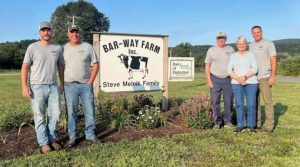
As they say if all cows in the world performed at same standard as the average US cow would reduce the global carbon footprint by 90%. Despite this it is an irony that the most sustainable cows are still those that seek the most improvement and those producers are typically those embracing technology to make this happen.
In a year when dairy profitability is as good as any time in recent history, it might seem like a strange time to talk about the sustainability of our current model of milk production. Critics of dairy production don’t evaluate sustainability in terms of our ability to pass the farm to the next generation, and they are putting milk farms are squarely in the crosshairs. Livestock farming in general is the target of diverse groups, with Governments and even the UN focused on forcing changes in production. There are three main threats to Dairy: lowering the carbon footprint, assuring continued availability of affordable water and a qualified labor force.
Hotter summers, with the lack of rain and wildfires, have equally created havoc on our dairy farms. The resulting challenges are clear. Water consumption and increased water prices presents clear and real dangers, while working in over 100 degrees presents challenges in finding the right people to work on the farm.
The word sustainability is challenging to address when it is defined differently by different agencies. Add to that questions that ESG as it is becoming increasingly known accommodates a lot of different and competing demands which can be contradictory. Farmers concern is that ESG is a stick to beat them with, a slippery slope of activist demands, often out of step with the delivery of food that today is affordable and safe.
What is the path out of this? The food business demonstrates what is possible, re-imagine sustainability through better farming. Technology is part of how producers respond to ESG demands.
WATER RECYCLING
Water on the farm is critical to cows, washing the barns and milking parlors, and not least cooling cows in hot weather. Finding ways to purify water and make it potable from manure, farm waste, is the work of different startups and scale ups including Livestock Water Recycling (LWR) who have been part of the World Dairy Tech Spotlight and more recently US dairies have installed Sedron Technologies and Regenis to separate manure into fertilizer and drinkable water.
METHANE CAPTURE
Methane digestors not only capture a greenhouse gas from manure, and can receive credits for that, but can become even more cash positive when the use of food waste makes the farm energy positive. Over 40 companies are now offering different methane digestors to US Dairy producers. California legislation has driven interest in this area but half a dozen more states are considering similar rules, but challenges remain since most farm methane digestors haven’t been profitable on their own, and without grants would never have been funded. Will methane generate more revenue than milk? The Dynamic Group suggest that methane can boost revenue per cow by 10-30%.
ALTERNATIVE ENERGY
The use of wind turbines is so common that cattle often use their shadow to shelter when outside from the sun. Solar panels are becoming common also so its not surprising that farm systems are being imagined where crops or livestock could use solar panels as shade or shelter and ‘agrovoltaics’ is the concept of creating synergies. If you aren’t familiar with it I recommend checking out out Iberdrola or the Massachusetts SMART program.
LABOR SAVING
US farms value labor as never before. Its not just the quantity of labor but also the availability of the most valuable workers; those who through a cow-centric approach and understanding cow-comfort recognize things that the average employee does not, no matter how hard they work. The use of Robotics continues to explode in the US and globally milking cows, cleaning barns, automating feed pushups and now Pharm Robotics is doing robotic vaccinations in US Dairy. Cow sensors have continued to grow in usage, with Antilleq monitoring over 1 million US cows and another dozen providers offering different wearables most notably Nedap’s CowControl. Sensors such as the recent launch of the Labby hand-held milk sensor, EIO and SomaDetect, allow producers to identify milk quality and indicators of cow health in real time. Camera solutions continue to grow (Cainthus, Cattle Eye, CattleCare) both in the milking parlor and in the barn to identify cow comfort, manage feed costs and identify problems in cows and the milk procedures. The goal of such technologies is to save money and time, through productivity, but the main success has been when it informs better, faster, decision making by farm workers.
As I opened with in this article, however, the best way forward to lower the footprint of dairy farms is to increase the productivity per cow in terms of milk production, and the conversion of nutrition into milk. Researchers also suggest that the carbon footprint of a cow with more lactations is lower than a cow with fewer. One proposal to improve the sustainability of dairy production globally has been to bring all cows up to US productivity levels, and in such a case the world wouldn’t need to have 300 million cows but just 30. More radically if cloning is allowed, and we could achieve the same level of milk production from all cows as we have with a cow with the world’s record for production, we could cut the global herd to just 3 million cows. Activists may not be ready for this solution, but it demonstrates the core fact that highly productive farms are also the ones with the lowest environmental footprint. And the best farms in the world are those who are embracing technology most quickly, and likely to continue to maintain their lead over their less-performing counterparts.

























